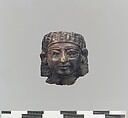Female head
Not on view
This carved head was probably blackened through exposure to fire when the palace complexes at Nimrud were sacked during the final defeat of Assyria at the end of the seventh century B.C. Originally, this piece may have been part of a composite statuette made of various materials and overlaid with gold foil. The top of the head is flattened, suggesting an additional piece was originally attached, perhaps a headdress. The chin-length hair is divided into thick plaits, with a thin, simple diadem visible across the forehead. The eyebrows and pupils of the eyes are drilled, indicating that they were likely inlaid in colored glass or semiprecious stones. As the head is beardless, it may represent either a female figure or a eunuch. Eunuchs, who were castrated men, served in many high-level positions in the Assyrian court and are frequently represented on the stone reliefs that decorate the walls of the Northwest Palace at Nimrud.
Built by the Assyrian king Ashurnasirpal II, the palaces and storerooms of Nimrud housed thousands of pieces of carved ivory. Most of the ivories served as furniture inlays or small precious objects such as boxes. While some of them were carved in the same style as the large Assyrian reliefs lining the walls of the Northwest Palace, the majority of the ivories display images and styles related to the arts of North Syria and the Phoenician city-states. Phoenician style ivories are distinguished by their use of imagery related to Egyptian art, such as sphinxes and figures wearing pharaonic crowns, and the use of elaborate carving techniques such as openwork and colored glass inlay. North Syrian style ivories tend to depict stockier figures in more dynamic compositions, carved as solid plaques with fewer added decorative elements. However, some pieces do not fit easily into any of these three styles. Most of the ivories were probably collected by the Assyrian kings as tribute from vassal states, and as booty from conquered enemies, while some may have been manufactured in workshops at Nimrud. The ivory tusks that provided the raw material for these objects were almost certainly from African elephants, imported from lands south of Egypt, although elephants did inhabit several river valleys in Syria until they were hunted to extinction by the end of the eighth century B.C.
Due to rights restrictions, this image cannot be enlarged, viewed at full screen, or downloaded.

